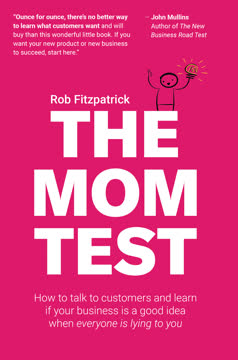Key Takeaways
1. Transition to leadership: Shift from doing to enabling others
Your job is to get results through the creativity, expertise, and energy of others.
Redefine success. As a new manager, you must shift your mindset from individual contributor to team enabler. Success is no longer measured by your personal output, but by your team's collective achievements. This requires developing new skills like delegating effectively, coaching team members, and setting clear expectations.
Manage expectations. Understand that your role now involves balancing the needs of your team, your superiors, and the organization as a whole. You'll need to:
- Communicate organizational goals and priorities to your team
- Advocate for your team's needs to upper management
- Make difficult decisions that may not please everyone
Develop new competencies. To excel in this new role, focus on developing:
- Strategic thinking: See the big picture and align team efforts with organizational goals
- People management: Motivate, develop, and retain talented team members
- Conflict resolution: Navigate disagreements and foster a positive team culture
- Decision-making: Make tough calls with incomplete information
2. Build trust and credibility through character and competence
People trust you when you are genuine and authentic, not a replica of someone else.
Demonstrate character. Build trust by consistently displaying integrity, honesty, and ethical behavior. This involves:
- Following through on commitments
- Admitting mistakes and taking responsibility
- Treating all team members fairly and with respect
- Making decisions that prioritize the team's and organization's interests
Showcase competence. Prove your capabilities through:
- Delivering results and meeting deadlines
- Staying current with industry trends and best practices
- Solving complex problems effectively
- Providing valuable insights and guidance to your team
Practice authentic leadership. Develop your unique leadership style by:
- Reflecting on your personal values and experiences
- Understanding your strengths and weaknesses
- Being transparent about your motivations and decision-making process
- Adapting your approach while staying true to your core principles
3. Develop emotional intelligence to lead effectively
Emotional intelligence is a more powerful determinant of good leadership than technical competence, IQ, or vision.
Self-awareness. Understand your own emotions, triggers, and impact on others:
- Regularly reflect on your feelings and reactions
- Seek feedback from colleagues and mentors
- Identify patterns in your behavior and emotional responses
Self-regulation. Manage your emotions effectively:
- Practice stress-management techniques like deep breathing or meditation
- Take a pause before reacting in challenging situations
- Choose appropriate responses rather than impulsive reactions
Social awareness. Develop empathy and understanding of others' emotions:
- Pay attention to nonverbal cues and body language
- Listen actively and ask clarifying questions
- Consider different perspectives and cultural backgrounds
Relationship management. Use emotional intelligence to build strong relationships:
- Provide constructive feedback with empathy
- Resolve conflicts by addressing underlying emotions
- Inspire and motivate team members by connecting with their aspirations
4. Align your team with organizational strategy
Articulating a vision always goes beyond the numbers that are typically found in five-year plans.
Understand the big picture. Gain a deep understanding of your organization's:
- Mission, vision, and values
- Short-term and long-term strategic objectives
- Competitive landscape and market trends
Translate strategy for your team. Help your team members see how their work contributes to larger organizational goals:
- Break down high-level objectives into specific team and individual goals
- Regularly discuss the connection between daily tasks and strategic priorities
- Celebrate team achievements that directly support organizational strategy
Adapt to change. Stay agile and help your team navigate shifts in strategy:
- Anticipate potential changes in the business environment
- Communicate strategic updates clearly and promptly
- Help team members develop skills that align with future organizational needs
5. Master communication to influence and inspire
If you can't communicate the vision to someone in five minutes or less and get a reaction that signifies both understanding and interest, you are not yet done.
Tailor your message. Adapt your communication style to your audience:
- Consider the listener's background, priorities, and preferred communication style
- Use appropriate levels of detail for different stakeholders
- Choose the right medium (e.g., email, presentation, one-on-one conversation) for each message
Develop compelling narratives. Use storytelling techniques to make your messages more engaging and memorable:
- Start with a clear purpose or problem statement
- Use concrete examples and analogies to illustrate key points
- Conclude with a clear call to action or next steps
Practice active listening. Improve your ability to understand and respond to others:
- Give your full attention to the speaker
- Ask clarifying questions and paraphrase to confirm understanding
- Show empathy and acknowledge others' perspectives
6. Optimize personal productivity and work-life balance
To achieve your strategic objectives in this role and feel satisfied with your life overall, you need to take charge of your personal productivity.
Prioritize effectively. Focus on high-impact activities:
- Use tools like the Eisenhower Matrix to categorize tasks by importance and urgency
- Regularly review and adjust your priorities
- Learn to say no to low-value requests
Manage your time. Implement time management techniques:
- Block time for focused work and important tasks
- Use the Pomodoro Technique for better concentration
- Batch similar tasks to reduce context switching
Maintain work-life balance. Prioritize your well-being:
- Set clear boundaries between work and personal time
- Practice stress-reduction techniques like exercise or meditation
- Regularly unplug from work to recharge and gain perspective
7. Foster employee growth and development
Employee development doesn't need to be about facilitating your employees' meteoric rise to the top; it's more about helping them achieve this fundamental satisfaction in their everyday work and reach their highest potential, whatever that might be.
Understand individual aspirations. Have regular career conversations with team members:
- Discuss their long-term goals and aspirations
- Identify skills they want to develop
- Understand their motivations and values
Provide growth opportunities. Create a culture of continuous learning:
- Assign stretch projects that challenge team members
- Encourage cross-functional collaboration and knowledge sharing
- Support formal training and education opportunities
Offer meaningful feedback. Help employees improve through constructive feedback:
- Provide specific, actionable feedback regularly
- Balance positive reinforcement with areas for improvement
- Encourage self-reflection and self-assessment
8. Create high-performing teams through diversity and collaboration
Leaders are as likely to be listening as talking.
Build diverse teams. Bring together individuals with varied:
- Skills and expertise
- Backgrounds and experiences
- Thinking styles and perspectives
Foster psychological safety. Create an environment where team members feel comfortable taking risks:
- Encourage open communication and idea-sharing
- View mistakes as learning opportunities
- Model vulnerability by admitting your own errors and uncertainties
Promote collaboration. Implement strategies to enhance teamwork:
- Clearly define roles and responsibilities
- Establish shared goals and performance metrics
- Use collaborative tools and technologies effectively
9. Stimulate creativity and innovation within your team
Creativity doesn't just come from "creative" people.
Create space for ideation. Designate time and resources for creative thinking:
- Schedule regular brainstorming sessions
- Provide tools and environments that spark creativity
- Encourage experimentation and prototyping
Challenge assumptions. Push your team to think differently:
- Ask thought-provoking questions
- Encourage diverse perspectives and healthy debate
- Expose team members to new ideas and experiences
Implement innovation processes. Establish systems to turn ideas into reality:
- Create a clear process for evaluating and prioritizing ideas
- Allocate resources for testing and implementing promising concepts
- Celebrate both successes and failures as learning opportunities
10. Recruit, retain, and motivate top talent
Hire for potential, not just experience.
Attract top talent. Develop a compelling employee value proposition:
- Highlight opportunities for growth and development
- Showcase your organization's culture and values
- Offer competitive compensation and benefits packages
Retain high performers. Create an environment where top talent thrives:
- Provide challenging work and opportunities for advancement
- Recognize and reward exceptional performance
- Foster a positive work culture and strong team relationships
Motivate your team. Understand and leverage individual motivators:
- Connect work to personal and professional goals
- Provide autonomy and ownership over projects
- Offer regular feedback and recognition
11. Understand financial fundamentals to make informed decisions
Numbers aren't infallible. Question your data sources and be critical about the kinds of questions you apply financial techniques to.
Master key financial statements. Understand the basics of:
- Balance sheets: Assets, liabilities, and equity
- Income statements: Revenue, expenses, and profit
- Cash flow statements: Operating, investing, and financing activities
Use financial metrics. Apply relevant metrics to assess performance:
- Profitability ratios (e.g., gross margin, net profit margin)
- Efficiency ratios (e.g., inventory turnover, accounts receivable turnover)
- Liquidity ratios (e.g., current ratio, quick ratio)
Make data-driven decisions. Use financial insights to inform strategy:
- Analyze trends and patterns in financial data
- Consider both short-term and long-term financial implications
- Balance financial considerations with other strategic factors
12. Craft compelling business cases to drive change
Building a business case relies on both the "soft" and "hard" skills you've learned in this book, from persuasion to financial analysis.
Identify the need. Clearly articulate the problem or opportunity:
- Gather data to support your case
- Link the need to organizational goals and priorities
- Quantify the potential impact (financial and non-financial)
Develop a robust solution. Create a well-thought-out proposal:
- Consider multiple alternatives
- Conduct a thorough cost-benefit analysis
- Address potential risks and mitigation strategies
Present persuasively. Tailor your pitch to your audience:
- Use clear, concise language
- Support your arguments with compelling data and examples
- Anticipate and address potential objections
- Clearly outline next steps and required resources
By mastering these key areas, you'll be well-equipped to navigate the challenges of management and leadership, driving both personal and organizational success.
Last updated:
FAQ
What's Harvard Business Review Manager's Handbook about?
- Leadership Skills Focus: The book outlines 17 essential skills for leaders to excel in their roles, emphasizing the transition from individual contributor to manager.
- Practical Guidance: It offers practical tips, step-by-step instructions, and real-world examples to help managers navigate their responsibilities effectively.
- Comprehensive Structure: Divided into five parts, it covers developing a leader mindset, managing oneself, individuals, teams, and the business, creating a holistic management approach.
Why should I read Harvard Business Review Manager's Handbook?
- Skill Development: Ideal for enhancing management skills, it addresses common challenges and provides actionable solutions for both new and seasoned managers.
- Research-Based Insights: The content is grounded in research and best practices from leading management and leadership experts.
- Real-World Application: Includes stories from real managers, making it relatable and applicable to everyday situations.
What are the key takeaways of Harvard Business Review Manager's Handbook?
- Transition to Leadership: Understanding the shift from individual contributor to manager is crucial, focusing on team achievements.
- Building Trust and Credibility: Establishing trust is fundamental, requiring managers to demonstrate character and competence.
- Emotional Intelligence Importance: Emotional intelligence is a key determinant of successful leadership, enhancing self-awareness, self-regulation, and empathy.
What are the best quotes from Harvard Business Review Manager's Handbook and what do they mean?
- "Set direction for your team": Emphasizes the manager's role in guiding their team towards organizational objectives.
- "Leadership is a learnable skill": Highlights that anyone can develop leadership skills through practice and learning.
- "Trust is the most powerful tool": Underscores the importance of trust in team dynamics for better collaboration and results.
How does Harvard Business Review Manager's Handbook define emotional intelligence?
- Definition of EQ: Emotional intelligence is the ability to perceive and manage emotions effectively in oneself and others.
- Components of EQ: Includes self-awareness, self-regulation, motivation, empathy, and social skills, all crucial for leadership.
- Impact on Leadership: High EQ is a more powerful determinant of good leadership than technical competence or IQ.
What strategies does Harvard Business Review Manager's Handbook suggest for effective delegation?
- Create a Delegation Plan: Develop a written plan outlining the task, purpose, and expected outcomes for clarity and accountability.
- Choose the Right Person: Select employees based on skills, availability, and motivation to ensure successful task completion.
- Monitor Progress: Regular check-ins support employees and keep projects on track without micromanaging.
How can I build trust and credibility as a manager according to Harvard Business Review Manager's Handbook?
- Demonstrate Character: Align actions with stated values to establish trust and reinforce credibility.
- Show Competence: Demonstrate technical and operational knowledge to build confidence in abilities.
- Invite Feedback: Actively seek feedback to show commitment to self-improvement and foster a culture of trust.
What is the importance of self-development in Harvard Business Review Manager's Handbook?
- Proactive Career Management: Individuals must take charge of their growth and development in a rapidly changing work environment.
- Aligning Goals: Self-development helps align personal aspirations with organizational needs, benefiting both parties.
- Continuous Learning: Ongoing skill enhancement is necessary to adapt to new challenges and remain competitive.
How does Harvard Business Review Manager's Handbook suggest managing stress and maintaining productivity?
- Time Management Techniques: Track time usage to identify patterns and prioritize tasks effectively.
- Finding Focus: Minimize distractions and create a conducive work environment to enhance concentration.
- Stress Management Practices: Incorporate routines like breaks, exercise, and mindfulness to mitigate stress.
What are the key components of effective communication as outlined in Harvard Business Review Manager's Handbook?
- Finding Your Voice: Develop an authentic communication style using rhetorical techniques to engage the audience.
- Mastering Written Communication: Ensure messages are clear and impactful through preparation, drafting, and editing.
- Conducting Effective Meetings: Plan inclusive meetings with clear objectives and follow-ups to maintain accountability.
How does Harvard Business Review Manager's Handbook address delegation?
- Clear Definition of Tasks: Clearly define tasks before delegating to ensure team members understand responsibilities.
- Trusting Your Team: Empower team members by trusting them to complete tasks without micromanaging.
- Monitoring Progress: Regular check-ins help ensure projects stay on track and provide opportunities for feedback.
What strategies for giving effective feedback are discussed in Harvard Business Review Manager's Handbook?
- Timeliness is Key: Provide feedback in real-time to reinforce positive behaviors and correct issues promptly.
- Constructive Criticism: Use a balanced approach, combining praise with constructive criticism to encourage growth.
- Focus on Development: Frame feedback to highlight opportunities for skill improvement and development.
Review Summary
Harvard Business Review Manager's Handbook receives mostly positive reviews, with an average rating of 4.14/5. Readers appreciate its comprehensive coverage of essential management skills, practical advice, and actionable tips. Many find it valuable for new managers and a useful reference for experienced leaders. Some reviewers note that while it covers many topics, it doesn't delve deeply into any single area. The book is praised for its clear writing, case studies, and focus on both personal development and team management. Several readers recommend it as a go-to guide for managers at all levels.
Similar Books










Download PDF
Download EPUB
.epub digital book format is ideal for reading ebooks on phones, tablets, and e-readers.













